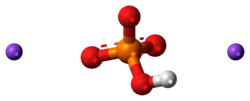Disodium phosphate
 | |
 | |
| Names | |
|---|---|
| IUPAC name
Sodium hydrogen phosphate | |
| Other names
Disodium hydrogen orthophosphate Sodium hydrogen phosphate Sodium phosphate dibasic disodium phosphate | |
| Identifiers | |
| 7558-79-4 10028-24-7 (dihydrate) 7782-85-6 (heptahydrate) 10039-32-4 (dodecahydrate) | |
| 3D model (Jmol) | Interactive image |
| ChEBI | CHEBI:34683 |
| ChEMBL | ChEMBL1060 |
| ChemSpider | 22625 |
| ECHA InfoCard | 100.028.590 |
| EC Number | 231-448-7 |
| PubChem | 24203 |
| RTECS number | WC4500000 |
| UNII | 22ADO53M6F |
| |
| |
| Properties | |
| Na2HPO4 | |
| Molar mass | 141.96 g/mol (anhydrous) 268.07 g/mol (heptahydrate) |
| Appearance | White crystalline solid |
| Odor | odorless |
| Density | 1.7 g/cm3 |
| Melting point | 250 °C (482 °F; 523 K) decomposes |
| 7.7 g/100 ml (20 °C) 11.8 g/100 mL (25 °C, heptahydrate) | |
| Solubility | insoluble in alcohol |
| log P | -5.8 |
| Acidity (pKa) | 12.35 |
| Refractive index (nD) |
1.35644..1.35717 at 20°C |
| Hazards | |
| Main hazards | Irritant |
| Safety data sheet | ICSC 1129 |
| NFPA 704 | |
| Flash point | Non-flammable |
| Lethal dose or concentration (LD, LC): | |
| LD50 (median dose) |
17000 mg/kg (rat, oral) |
| Related compounds | |
| Other anions |
sodium phosphite |
| Other cations |
Dipotassium phosphate Diammonium phosphate |
| Related compounds |
Monosodium phosphate Trisodium phosphate |
| Except where otherwise noted, data are given for materials in their standard state (at 25 °C [77 °F], 100 kPa). | |
| | |
| Infobox references | |
Disodium phosphate (DSP), or sodium hydrogen phosphate, is the inorganic compound with the formula Na2HPO4. It is one of several sodium phosphates. The salt is known in anhydrous form as well as forms with 2, 7, 8, and 12 hydrates. All are water-soluble white powders; the anhydrous salt being hygroscopic.[1]
Acid-base properties
The pH of disodium hydrogen phosphate water solution is between 8.0 and 11.0, meaning it is moderately basic:
- HPO42− + H2O ⇌ H2PO4− + OH−
Production and reactions
It can be generated by neutralization of phosphoric acid with sodium hydroxide:
- H3PO4 + 2 NaOH → HNa2PO4 + 2 H2O
Industrially It is prepared in a two-step process by treating dicalcium phosphate with sodium bisulfate, which precipitates calcium sulfate:[2]
- CaHPO4 + NaHSO4 → NaH2PO4 + CaSO4
In the second step, the resulting solution of monosodium phosphate is partially neutralized:
- NaH2PO4 + NaOH → HNa2PO4 + H2O
Uses
It is used in conjunction with trisodium phosphate in foods and water softening treatment. In foods, it is used to adjust pH. Its presence prevents coagulation in the preparation of condensed milk. Similarly, it is used as an anti-caking additive in powdered products.[3] It is used in desserts and puddings, e.g. Cream of Wheat to quicken cook time, and Jell-O Instant Pudding for thickening. In water treatment, it retards calcium scale formation. It is also found in some detergents and cleaning agents.[2]
Heating solid disodium phosphate gives the useful compound tetrasodium pyrophosphate:
- 2 HNa2PO4 → Na4P2O7 + H2O
Monobasic and dibasic sodium phosphate are used as a saline laxative to treat constipation or to clean the bowel before a colonoscopy.[4]
References
- ↑ Physical data (pdf)
- 1 2 Klaus Schrödter, Gerhard Bettermann, Thomas Staffel, Friedrich Wahl, Thomas Klein, Thomas Hofmann "Phosphoric Acid and Phosphates" in Ullmann’s Encyclopedia of Industrial Chemistry 2008, Wiley-VCH, Weinheim. doi:10.1002/14356007.a19_465.pub3
- ↑ MSDS
- ↑ "Sodium Phosphate, Dibasic, Sodium Phosphate, Monobasic Oral solution". Krames Patient Education.
